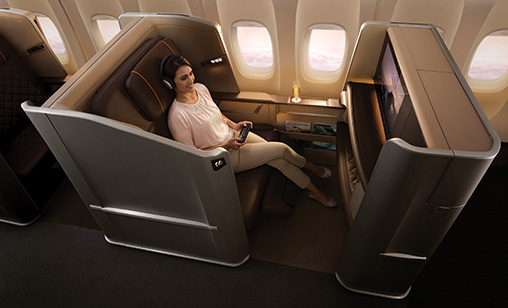News Backgrounder
Asia-Pacific fears drop-off in premium passengers as pandemic recedes
September 1st 2020
Business class cabins, crucial to airline profitability, are taking to the air almost empty. Read More » The critical question for carriers is will premium class demand return to past levels after COVID-19 eases? Can corporate travellers, having spent months using social media tools such Zoom, Skype and Microsoft Teams, be lured back?
The threat of online internet communication to airlines is nothing new, but some observers believe this time around returning business class traffic to the glory days of 2019 is going to be more challenging than in previous industry crises.
 |
“Whether we see a recovery to pre-crisis business travel patterns remains to be seen,” said International Air Transport (IATA) chief economist, Brian Pearce, in a media briefing last month.
“Our concern is we won’t. Corporate buyers are imposing some very severe travel policies at the moment. I think we will see much less business travel to company offices. This has some pretty big consequences to the industry, at least in the short term.”
Pearce said for many network airlines the premium paying passenger drives the profitability of their businesses and was particularly important to the viability of long-haul services.
Association of Asia Pacific Airlines (AAPA) director general, Subhas Menon, has predicted a slow return to business class normality. “No traffic is going to return to last year’s levels in the near future. My assumption is we will be lucky in the first year if it is 30% of what it was. Of that 30% I would say the large majority of it will be returnees and VFR (visiting friends and relatives) and business will be just a little bit,” he said.
There would be an impact on the business class sector not only because of personal finances but because corporate revenue is being affected by the pandemic and the economic downturn.
“So when business people travel they will downgrade. They will not be flying business class but economy. Yields will come down quite significantly,” Menon predicted.
Analysts forecast the “hassle factor” will be another deterrent to a business travel revival. Given a choice of flying that required COVID-19 testing and certification, distancing rules, mask wearing and possible quarantine periods and conducting business with video conferences, the latter option is a more attractive proposition, it is believed.
“At the outset of the global pandemic we were pretty confident the second half of 2020 could be that time [when corporate travel], with initial small steps would revive, but as the year progresses that feeling is subsiding for many. Multiple events initially pushed from the first half of 2020 to the second half of the year are being cancelled or moved exclusively online as many in this space write off 2020 from a physical meeting standing at least,” Informa consultancy, CAPA, said.
In his briefing, Pearce went as far as suggesting revenue from air freight, a sector performing quite well in the COVID-19 crisis, could replace premium traffic as a major source of revenue for airlines - at least in the immediate future.
It is a forecast supported by IATA’s latest survey of airline chief financial officers and heads of cargo, conducted in mid-July. The majority of respondents (77%) saw profits decline in their second quarter, a slightly lower share than in a similar survey in April. On the other hand, 19% of respondents reported an improvement in profits, underpinned by strong demand for air cargo.
| 'Those people who are going to travel for business are really people who need to travel on essential business. They are people who are using factories overseas to produce their goods. They need to go and make arrangements and negotiate the raw materials. They have to make sure the supply chains are correct. It is very essential work they need to do and they need to travel. They probably can’t do it by video. If you are going to rely on a factory in China and you are sitting in Australia it is going to be very difficult for you to do it through video conferencing. If you are producing your goods in India or Indonesia you need to travel' |
| Subhas Menon Association of Asia-Pacific Airlines director general |
Belly capacity has almost disappeared with the grounding of much of the global passenger fleet, but cargo yields have soared. As a result, some airlines quickly shifted focus to cargo in the absence of passenger flights. Forward looking profitability expectations did strengthen compared with April, but respondent expectations are still in contractionary territory.
The majority (68%) of those surveyed told IATA they expected deterioration or no improvement in profits in the year ahead because border restrictions were being lifted slowly and restoring passenger confidence in flying was taking time.
Nevertheless, Pearce reminded his audience warnings online business meetings posing a threat to the airline industry were nothing new. “For decades, people have been predicting the end of business travel because of video conferencing technologies. It has never happened,” he said.
“Clearly, the experience of the last few months has shown many businesses have operated these online technologies. It will have an effect in the short term. We have been speaking to a number of corporate travel buyers and we have heard some interesting views, one of them being these technologies make them much more productive. They can speak to many more clients in a day.
“But they will still have to visit them to close a deal or cement a relationship. Yes, there will be some impact, but I don’t think it is going to bring an end to face-to-face meetings. Business travel by air will still be required to do that.”